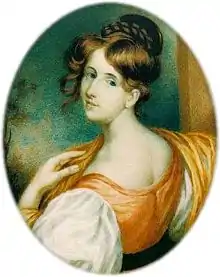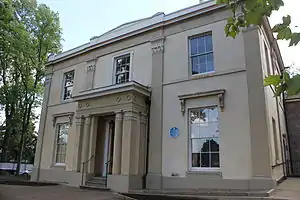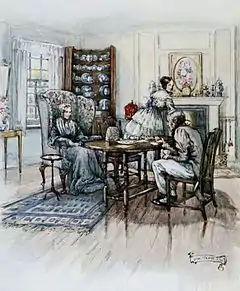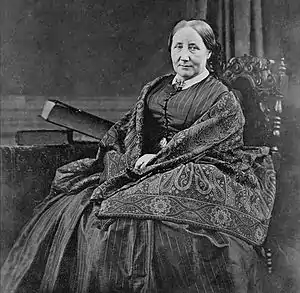Elizabeth Gaskell
Elizabeth Cleghorn Gaskell (née Stevenson; 29 September 1810 – 12 November 1865), often referred to as Mrs Gaskell, was an English novelist, biographer and short story writer. Her novels offer a detailed portrait of the lives of many strata of Victorian society, including the very poor. Her work is of interest to social historians as well as readers of literature. Her first novel, Mary Barton, was published in 1848. Gaskell's The Life of Charlotte Brontë, published in 1857, was the first biography of Charlotte Brontë. In this biography, she wrote only of the moral, sophisticated things in Brontë’s life; the rest she left out, deciding that certain, more salacious aspects were better kept hidden. Among Gaskell's best known novels are Cranford (1851–53), North and South (1854–55), and Wives and Daughters (1865), each having been adapted for television by the BBC.
Elizabeth Gaskell | |
|---|---|
 Elizabeth Gaskell: 1832 miniature by William John Thomson | |
| Born | Elizabeth Cleghorn Stevenson 29 September 1810 Chelsea, London, England |
| Died | 12 November 1865 (aged 55) Holybourne, Hampshire, England |
| Occupation | Novelist |
| Nationality | English |
| Period | 1848–1865 |
| Spouse | |
| Children | Marianne Margaret Emily (Meta) Florence Elizabeth William Julia Bradford |
Early life
Gaskell was born Elizabeth Cleghorn Stevenson on 29 September 1810 in Lindsey Row, Chelsea, London, at the house that is now 93 Cheyne Walk.[1] She was the youngest of eight children; only she and her brother John survived infancy. Her father, William Stevenson, a Unitarian from Berwick-upon-Tweed, was minister at Failsworth, Lancashire, but resigned his orders on conscientious grounds; he moved to London in 1806 with the intention of going to India after he was appointed private secretary to the Earl of Lauderdale, who was to become Governor General of India. That position did not materialise, however, and instead, Stevenson was nominated Keeper of the Treasury Records.
His wife, Elizabeth Holland, came from a family established in Lancashire and Cheshire that was connected with other prominent Unitarian families, including the Wedgwoods, the Martineaus, the Turners and the Darwins. When she died 13 months after giving birth to her youngest daughter,[2] she left a bewildered husband who saw no alternative but to send Elizabeth to live with her mother's sister, Hannah Lumb, in Knutsford, Cheshire.[3] Elizabeth's future while she was growing up was uncertain, as she had no personal wealth and no firm home, though she was a permanent guest at her aunt and grandparents' house.
Her father remarried, to Catherine Thomson, in 1814. They had a son, William, in 1815, and a daughter, Catherine, in 1816. Although Elizabeth spent several years without seeing her father, to whom she was devoted, her older brother John often visited her in Knutsford. John was destined for the Royal Navy from an early age, like his grandfathers and uncles, but he did not obtain preferment into the Service and had to join the Merchant Navy with the East India Company's fleet.[4] John went missing in 1827 during an expedition to India.
Character and influences
A beautiful young woman, Elizabeth was well-groomed, tidily dressed, kind, gentle, and considerate of others. Her temperament was calm and collected, joyous and innocent, she reveled in the simplicity of rural life. Much of Elizabeth's childhood was spent in Cheshire, where she lived with her aunt Hannah Lumb in Knutsford, the town she immortalized as Cranford. They lived in a large red-brick house called The Heath (now Heathwaite).[5][6]
From 1821 to 1826 she attended a school run by the Misses Byerley at Barford House and afterward at Avonbank in Stratford-on-Avon,[2] where she received the traditional education in arts, the classics, decorum and propriety given to young ladies from relatively wealthy families at the time. Her aunts gave her the classics to read, and she was encouraged by her father in her studies and writing. Her brother John sent her modern books, and descriptions of his life at sea and his experiences abroad.[7]
After leaving school at the age of 16, Elizabeth traveled to London to spend time with her Holland cousins.[7] She also spent some time in Newcastle upon Tyne (with the Rev William Turner's family) and from there made the journey to Edinburgh. Her stepmother's brother was the miniature artist William John Thomson, who in 1832 painted a portrait of Elizabeth Gaskell in Manchester. A bust was sculpted by David Dunbar at the same time.[7]
Married life and writing career

On 30 August 1832 Elizabeth married a Unitarian minister, William Gaskell, in Knutsford. They spent their honeymoon in North Wales, staying with her uncle, Samuel Holland, near Porthmadog. The Gaskells then settled in Manchester, where William was the minister at Cross Street Unitarian Chapel. Manchester's industrial surroundings influenced Elizabeth's writing in the industrial genre. Their first child, a daughter, was stillborn in 1833. Their other children were Marianne (1834), Margaret Emily, known as Meta (1837), Florence Elizabeth (1842), and Julia Bradford (1846). Marianne and Meta boarded at the private school conducted by Rachel Martineau, sister of Harriet, a close friend of Elizabeth.[8] Florence married Charles Crompton, a barrister and Liberal politician, in 1863.[2]
In March 1835 Gaskell began a diary documenting the development of her daughter Marianne: she explored parenthood, the values she placed on her role as a mother; her faith, and, later, relations between Marianne and her sister, Meta. In 1836 she co-authored with her husband a cycle of poems, Sketches among the Poor, which was published in Blackwood's Magazine in January 1837. In 1840 William Howitt published Visits to Remarkable Places containing a contribution entitled Clopton Hall by "A Lady", the first work was written and published solely by her. In April 1840 Howitt published The Rural Life of England, which included a second work titled Notes on Cheshire Customs.[2]
In July 1841 the Gaskells traveled to Belgium and Germany. German literature came to have a strong influence on her short stories, the first of which she published in 1847 as Libbie Marsh's Three Eras, in Howitt's Journal, under the pseudonym "Cotton Mather Mills". But other influences including Adam Smith's Social Politics enabled a much wider understanding of the cultural milieu in which her works were set. Her second story printed under the pseudonym was The Sexton's Hero. And she made her last use of it in 1848, with the publication of her story Christmas Storms and Sunshine.
A son, William, (1844–45), died in infancy, and this tragedy was the catalyst for Gaskell's first novel, Mary Barton. It was ready for publication in October 1848,[2] shortly before they made the move south. It was an enormous success, selling thousands of copies. Ritchie called it a "great and remarkable sensation." It was praised by Thomas Carlyle and Maria Edgeworth. She brought the teeming slums of manufacturing in Manchester alive to readers as yet unacquainted with crowded narrow alleyways. Her obvious depth of feeling was evident, while her turn of phrase and description was described as the greatest since Jane Austen.[9]
In 1850 the Gaskells moved to a villa at 84 Plymouth Grove.[10] She took her cow with her. For exercise, she would happily walk three miles to help another person in distress. In Manchester, Elizabeth wrote her remaining literary works, while her husband held welfare committees and tutored the poor in his study. The Gaskells' social circle included writers, journalists, religious dissenters, and social reformers such as William and Mary Howitt and Harriet Martineau. Poets, patrons of literature and writers such as Lord Houghton, Charles Dickens and John Ruskin visited Plymouth Grove, as did the American writers Harriet Beecher Stowe and Charles Eliot Norton, while the conductor Charles Hallé, who lived close by, taught piano to one of their daughters. Elizabeth's friend Charlotte Brontë stayed there three times, and on one occasion hid behind the drawing room curtains as she was too shy to meet the Gaskells' other visitors.[11][12]

In early 1850 Gaskell wrote to Charles Dickens asking for advice about assisting a girl named Pasley whom she had visited in prison. Pasley provided her with a model for the title character of Ruth in 1853. Lizzie Leigh was published in March and April 1850, in the first numbers of Dickens's journal Household Words, in which many of her works were to be published, including Cranford and North and South, her novella My Lady Ludlow, and short stories.
In June 1855 Patrick Brontë asked Gaskell to write a biography of his daughter Charlotte, and The Life of Charlotte Brontë was published in 1857. This played a significant role in developing Gaskell's own literary career.[2] In the biography, Gaskell chose to focus more on Brontë as a woman than as a writer of Romantic fiction.[13] In 1859 Gaskell traveled to Whitby to gather material for Sylvia's Lovers, which was published in 1863. Her novella Cousin Phyllis was serialized in The Cornhill Magazine from November 1863 to February 1864. The serialization of her last novel, Wives and Daughters, began in August 1864 in The Cornhill.[2] She died of a heart attack in 1865, while visiting a house she had purchased in Holybourne, Hampshire. Wives and Daughters was published in book form in early 1866, first in the United States and then, ten days later, in Britain.[2]
Reputation and re-evaluation
Gaskell's reputation from her death to the 1950s was epitomized by Lord David Cecil's assessment in Early Victorian Novelists (1934) that she was "all woman" and "makes a creditable effort to overcome her natural deficiencies but all in vain" (quoted in Stoneman, 1987, from Cecil, p. 235). A scathing unsigned review of North and South in The Leader accused Gaskell of making errors about Lancashire which a resident of Manchester would not make and said that a woman (or clergymen and women) could not "understand industrial problems", would "know too little about the cotton industry" and had no "right to add to the confusion by writing about it".[14]
Gaskell's novels, with the exception of Cranford, gradually slipped into obscurity during the late 19th century; before 1950, she was dismissed as a minor author with good judgement and "feminine" sensibilities. Archie Stanton Whitfield wrote that her work was "like a nosegay of violets, honeysuckle, lavender, mignonette and sweet briar" in 1929.[15] Cecil (1934) said that she lacked the "masculinity" necessary to properly deal with social problems (Chapman, 1999, pp. 39–40).
However, the critical tide began to turn in Gaskell's favour when, in the 1950s and 1960s, socialist critics like Kathleen Tillotson, Arnold Kettle and Raymond Williams re-evaluated the description of social and industrial problems in her novels (see Moore, 1999[16] for an elaboration), and—realizing that her vision went against the prevailing views of the time—saw it as preparing the way for vocal feminist movements.[17] In the early 21st century, with Gaskell's work "enlisted in contemporary negotiations of nationhood as well as gender and class identities",[18] North and South – one of the first industrial novels describing the conflict between employers and workers – was recognized as depicting complex social conflicts and offering more satisfactory solutions through Margaret Hale: spokesperson for the author and Gaskell's most mature creation.[19]
In her introduction to The Cambridge Companion to Elizabeth Gaskell (2007), a collection of essays representing the current Gaskell scholarship, Jill L. Matus stresses the author's growing stature in Victorian literary studies and how her innovative, versatile storytelling addressed the rapid changes during her lifetime.
Legacy
The house on Plymouth Grove remained in the Gaskell family until 1913, after which it stood empty and fell into disrepair. The University of Manchester acquired it in 1969 and in 2004 it was acquired by the Manchester Historic Buildings Trust, which then raised money to restore it. Exterior renovations were completed in 2011 and the house is now open to the public.[20][21]
On 25 September 2010, a memorial to Elizabeth Gaskell was dedicated to Poets' Corner in Westminster Abbey. It takes the form of a panel in the Hubbard memorial window, above the tomb of Geoffrey Chaucer. The panel was dedicated by her great-great-great-granddaughter Sarah Prince and a wreath was laid.[22]
Manchester City Council have created an award in Gaskell's name, given to recognize women's involvement in charitable work and improvement of lives.[23]
A bibliometric Mrs. Gaskell and me: Two Women, Two Love Stories, Two centuries Apart, by Nell Stevens was published in 2018.[24]
Literary style and themes

Gaskell's first novel, Mary Barton, was published anonymously in 1848. The best-known of her remaining novels are Cranford (1853), North and South (1854), and Wives and Daughters (1865). She became popular for her writing, especially her ghost stories, aided by Charles Dickens, who published her work in his magazine Household Words. Her ghost stories are in the "Gothic" vein, making them quite distinct from her "industrial" fiction.
Even though her writing conforms to Victorian conventions, including the use of the name "Mrs. Gaskell", she usually framed her stories as critiques of contemporary attitudes. Her early works focused on factory work in the Midlands. She usually emphasized the role of women, with complex narratives and realistic female characters.[25] Gaskell said she was influenced by the writings of Jane Austen. She then felt qualified to write a book on one of the greatest authors of all time, smoothing over patches in her life that were too rough for the sophisticated society woman.[26] Her treatment of class continues to interest social historians as well as fiction lovers.[27]
Themes
Unitarianism urges comprehension and tolerance toward all religions and even though Gaskell tried to keep her own beliefs hidden, she felt strongly about these values which permeated her works; in North and South, "Margaret the Churchwoman, her father the Dissenter, Higgins the Infidel, knelt down together. It did them no harm."[28][29]
Dialect usage
Gaskell's style is notable for putting local dialect words into the mouths of middle-class characters and the narrator. In North and South Margaret Hale suggests redding up (tidying) the Bouchers' house and even offers jokingly to teach her mother words such as knobstick (strike-breaker).[30] In 1854 she defended her use of dialect to express otherwise inexpressible concepts in a letter to Walter Savage Landor:
... you will remember the country people's use of the word "unked". I can't find any other word to express the exact feeling of strange unusual desolate discomfort, and I sometimes "potter" and "mither" people by using it.[30][31]
She also used the dialect word "nesh" (soft), which goes back to Old English, in Mary Barton:
Sit you down here: the grass is well nigh dry by this time; and you're neither of you nesh folk about taking cold.[32]
also in "North and South"
- And I did na like to be reckoned nesh and soft,[33]
and later in "The Manchester Marriage" [1858]:
- Now, I'm not above being neshed for other folks myself. I can stand a good blow, and never change colour; but, set me in the operating-room in the Infirmary, and I turn as sick as a girl.
- At Mrs Wilson's death Norah came back to them, as a nurse to the newly-born little Edwin; into which post she was not installed without a pretty strong oration on the part of the proud and happy father; who declared that if he found out that Norah ever tried to screen the boy by falsehood, or to make him nesh either in body or mind, she should go that very day.[34]
Publications

Source:[35]
Novels
- Mary Barton (1848)
- Cranford (1851–53)
- Ruth (1853)
- North and South (1854–55)
- My Lady Ludlow (1858)
- A Dark Night's Work (1863)
- Sylvia's Lovers (1863)
- Wives and Daughters: An Everyday Story (1864–66)
Novellas and collections
- The Moorland Cottage (1850)
- Mr. Harrison's Confessions (1851)
- The Old Nurse's Story (1852)
- Lizzie Leigh (1855)
- Round the Sofa (1859)
- Lois the Witch (1859; 1861)
- Cousin Phillis (1864)
- The Grey Woman and Other Tales (1865)
Short stories
- "Libbie Marsh's Three Eras" (1847)
- "The Sexton's Hero" (1847)
- "Christmas Storms and Sunshine" (1848)
- "Hand and Heart" (1849)
- "Martha Preston" (1850)
- "The Well of Pen-Morfa" (1850)
- "The Heart of John Middleton" (1850)
- "Disappearances" (1851)
- "Bessy's Troubles at Home" (1852)
- "The Old Nurse's Story" (1852)
- "Cumberland Sheep-Shearers" (1853)
- "Morton Hall" (1853)
- "Traits and Stories of the Huguenots" (1853)
- "My French Master" (1853)
- "The Squire's Story" (1853)
- "Company Manners" (1854)
- "Half a Life-time Ago" (1855)
- "The Poor Clare" (1856)
- "The Doom of the Griffiths" (1858)
- "An Incident at Niagara Falls" (1858)
- "The Sin of a Father" (1858), later republished as "Right at Last"
- "The Manchester Marriage" (1858)[36]
- "The Haunted House" (1859)[37]
- "The Ghost in the Garden Room" (1859), later "The Crooked Branch"
- "The Half Brothers" (1859)
- "Curious If True" (1860)
- "The Grey Woman" (1861)
- "Six weeks at Heppenheim" (1862)[38]
- "The Cage at Cranford" (1863)[38]
- "How the First Floor Went to Crowley Castle" (1863), republished as "Crowley Castle"[38]
- "A Parson's Holiday" (1865)
Non-fiction
- "Notes on Cheshire Customs" (1840)
- An Accursed Race (1855)
- The Life of Charlotte Brontë (1857)
- "French Life" (1864)
- "A Column of Gossip from Paris" (1865)
Poetry
- Sketches Among the Poor (with William Gaskell; 1837)
- Temperance Rhymes (1839)
See also
Notes
- "Elizabeth Gaskell Biography - The Gaskell Society". Gaskellsociety.co.uk. Retrieved 9 December 2017.
- Weyant, Nancy S. (2007). The Cambridge Companion to Elizabeth Gaskell; Chronology. Cambridge University Press. pp. xi–xx. ISBN 978-0-521-60926-5.
- Pollard, Arthur (1965). Mrs. Gaskell: Novelist and Biographer. Manchester University Press. p. 12. ISBN 0-674-57750-7.
- Gérin, Winifred (1976). Elizabeth Gaskell. Oxford University Press. pp. 10–17. ISBN 0-19-281296-3.
- Jenny Uglow (1993). Elizabeth Gaskell: A Habit of Stories. Faber & Faber. pp. 13–14. ISBN 0-571-20359-0.
- Heathside (now Gaskell Avenue), which faces the large open area of Knutsford Heath.
- Michell, Sheila (1985). Introduction to The Manchester Marriage. UK: Alan Sutton. pp. iv–viii. ISBN 0-86299-247-8.
- "The Gaskell Society Journal, Volume 22". The Gaskell Society. 2008. p. 57. Retrieved 25 April 2017.
Meta (Margaret Emily), the second daughter, was sent at about the same age as Marianne to Miss Rachel Martineau, ...
Cite magazine requires|magazine=(help) - Ritchie, p. xviii.
- Uglow J. Elizabeth Gaskell: A Habit of Stories (Faber and Faber; 1993) (ISBN 0-571-20359-0)
- Nurden, Robert (26 March 2006). "An ending Dickens would have liked". The Independent. London. Archived from the original on 30 September 2007.
- "Miss Meta Gaskell". The Spectator. 1 November 1913. Retrieved 25 April 2017.
LORD HOUGHTON once said that the conversation and society to be met within the house of the Gaskells at Manchester were the one thing which made life in that city tolerable for people of literary tastes. Miss Meta Gaskell, (daughter of Elizabeth Gaskell) who died last Sunday...
- Stone, Donald D. The Romantic Impulse in Victorian Fiction. Cambridge: Harvard University Press, 1980, p. 141.
- Chapman, edited by Alison (1999). Elizabeth Gaskell: Mary Barton North and South. Duxford: Icon Books. ISBN 9781840460377.CS1 maint: extra text: authors list (link)
- Whitfield, Archie Stanton (1929). Mrs. Gaskell, Her Life and Works. G. Routledge & sons. p. 258.
- "Archived copy". Archived from the original on 1 June 2010. Retrieved 14 June 2012.CS1 maint: archived copy as title (link)
- Stoneman, Patsy (1987). Elizabeth Gaskell. Bloomington: Indiana University Press. ISBN 9780253301031, p. 3.
- Matus, edited by Jill L. (2007). The Cambridge companion to Elizabeth Gaskell (repr. ed.). Cambridge, UK: Cambridge University Press. ISBN 9780521846769.CS1 maint: extra text: authors list (link), p. 9.
- Pearl L. Brown. "From Elizabeth Gaskell's Mary Barton To Her North And South: Progress Or Decline For Women?" Victorian Literature and Culture, 28, pp. 345–358.
- "Elizabeth Gaskell's House". www.elizabethgaskellhouse.org. Retrieved 1 December 2018.
- "Elizabeth Gaskell's house damaged after lead theft". BBC News. 11 May 2011.
- "Elizabeth Gaskell". www.westminster-abbey.org. Archived from the original on 19 August 2011. Retrieved 9 December 2017.
- "Veteran CND campaigner wins Elizabeth Gaskell award at age of 92". Manchester Evening News. 24 September 2010. Retrieved 26 January 2017.
- "A Funny Heartfelt Tribute to a Literary Giant", Irish Times, 29 September 2018.
- Excluding reference to Gaskell's Ghost Stories, Abrams, M. H., et al. (eds), "Elizabeth Gaskell, 1810–1865". The Norton Anthology of English Literature, The Major Authors: The Romantic Period through the Twentieth Century, 7th ed., Vol. B. New York, London: W.W. Norton & Company, 2001. ISBN 0-393-97304-2. DDC 820.8—dc21. LC PR1109.N6.
- Teacher, Janet Bukovinsky (1994). Women of Words. Frankfort, Germany: Courage Books. pp. 24. ISBN 9781561387694.
- PHILLIPS, V. (1 August 1978). "Children in Early Victorian England: Infant Feeding in Literature and Society, 1837-1857" (PDF). Journal of Tropical Pediatrics. 24 (4): 158–166. doi:10.1093/tropej/24.4.158. PMID 364073. Retrieved 9 December 2017.
- Gaskell, Elizabeth (1854–55). North and South. Penguin Popular Classics. p. 277. ISBN 978-0-14-062019-1.
- Easson, Angus (1979). Elizabeth Gaskell. Routledge & Kegan Paul. pp. 12–17. ISBN 0-7100-0099-5.
- Ingham, P. (1995). Introduction to the Penguin Classics edition of North and South.
- Chapple JAV, Pollard A, eds. The Letters of Mrs Gaskell. Mandolin (Manchester University Press), 1997
- Gaskell, E. (1848). "1". Mary Barton..
- Gaskell, Elizabeth (1854–55). North and South. Penguin Popular Classics. ISBN 978-0-14-062019-1.
- Stories of Successful Marriages. Victorian Short Stories. The Project Gutenberg..
- Nancy S. Weyant (2007), "Chronology", in Jill L. Matus (ed.), The Cambridge Companion to Elizabeth Gaskell, Cambridge University Press, ISBN 978-0-521-60926-5
- A chapter of A House to Let, co-written with Charles Dickens, Wilkie Collins, and Adelaide Anne Procter.
- Co-written with Charles Dickens, Wilkie Collins, Adelaide Proctor, George Sala and Hesba Stretton.
- Jenny Uglow (1999), "First Publication of Elizabeth Gaskell's Works", Elizabeth Gaskell (2nd ed.), Faber and Faber, pp. 617–19, ISBN 0-571-20359-0
External links
| Library resources about Elizabeth Gaskell |
| Wikimedia Commons has media related to Elizabeth Gaskell. |
| Wikisource has original works written by or about: Elizabeth Gaskell |
| Wikiquote has quotations related to: Elizabeth Gaskell |
- The Gaskell Society
- The Gaskell Society of Japan (Japanese)
- Elizabeth Gaskell's House
- Brook Street Unitarian Chapel and the Gaskell Grave
- A Hyper-Concordance to the Works of Elizabeth Gaskell
- The Gaskell Web
- The Victorian Web
- Works of Elizabeth Gaskell at The University of Adelaide Libraries
- Works by Elizabeth Cleghorn Gaskell at Project Gutenberg
- Works by Elizabeth Gaskell at Faded Page (Canada)
- Works by or about Elizabeth Gaskell at Internet Archive
- Works by Elizabeth Gaskell at LibriVox (public domain audiobooks)

- "Archival material relating to Elizabeth Gaskell". UK National Archives.

- The Visual Life of Elizabeth Gaskell
- Elizabeth Gaskell Manuscripts at the John Rylands Library, Manchester
- Elizabeth Gaskell at Find a Grave
- Elizabeth Gaskell at the British Library
- "Elizabeth Gaskell". Radio 4 Great Lives. BBC. 20 May 2005. Retrieved 2 July 2014.
- Archival material at Leeds University Library
- Elizabeth Gaskell: A Cranford Walk Around Knutsford, Past and Present (Youtube)
- The Grave of Elizabeth Gaskell, Brook Street Chapel, Knutsford (Youtube)